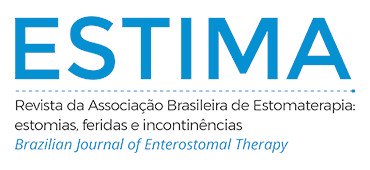Clinical and laboratory profile of hospitalized patients affected by pressure injury
Keywords:
Adulto, Hospitalização, lesão por pressãoAbstract
Objective: To characterize the clinical and laboratory profile of hospitalized patients affected by pressure injury (PI). Method: Retrospective and descriptive study, which included data from electronic medical records of 95 patients affected by PI during hospitalization. Results: There was a predominance of females (52.6%), mean age 74.8 ± 14 years, mean hospital stay was 76.9 ± 88.8 days. Most were admitted to the intensive care unit, with an average of 17.86 ± 36.58 days. Regarding the clinical condition, 60% were using a mechanical ventilator when they developed PI, 37.9% needed hemodialysis, 30.4% were diagnosed with some degree of protein-energy malnutrition and 54.7% progressed to death. The most frequent comorbidities were hypertension (63.16%), diabetes (43.16%) and neuropathy (33.68%). As for the laboratory profile, hypoalbuminemia (97.3%), hyperglycemia (87.8%), anemia (84.4%) and hyperuremia (78.9%) were present in more than two thirds of the sample. Conclusion: This study allowed to know the profile of patients affected by PI during hospitalization, which can serve as a basis for developing scientifically based effective preventive actions.
Downloads
Metrics
References
National Pressure Ulcer Advisory Panel. Pressure Ulcer Stages Revised [Internet]. Washington, DC: NPUAP; 2016. [citado em: 20 maio 2019]. Disponível em: http://www.npuap.org/resources/educational-and-clinical-resources/npuap-pressure-injury-stages/
Wada A, Neto NT, Ferreira MC. Úlceras por pressão. Rev Med: São Paulo. 2010;89(3/4),170-7.
Borghardt AT, Prado TN, Bicudo SDS, et al. Úlcera por pressão em pacientes críticos: incidência e fatores associados. Rev Bras Enferm. 2016;69(3),431-8. https://doi.org/10.1590/0034-7167.2016690307i
Mervis JS, Phillips TJ. Pressure Ulcers: Pathophysiology, Epidemiology, Risk Factors, and Presentation. Journal of the American Academy of Dermatology. 2019; 81(4),881-90. https://doi.org/10.1016/j.jaad.2018.12.069
Smit I, Harrison L, Letzkus L, et al. What Factors Are Associated With the Development of Pressure Ulcers in a Medical Intensive Care Unit? Dimensions of Critical Care Nursing. 2016;35(1),37-41. DOI: 10.1097/DCC.0000000000000153
Lima AFC, Castilho V, Baptista CMC, et al. Custo direto dos curativos de úlceras por pressão em pacientes hospitalizados. Revista Brasileira de Enfermagem. 2016;69(2), 290-7. https://doi.org/10.1590/0034-7167.2016690212i
Mendonça PK, Loureiro MDR, Ferreira Júnior MA, et al. Ocorrência e fatores de risco para lesões por pressão em centros de terapia intensiva. Revista de Enfermagem –UFPE. 2018;12(2),303-11. https://doi.org/10.5205/1981-8963-v12i2a23251p303-311-2018
González-Méndez MI, Lima-Serrano M, Martín-Castaño C, et al. Incidence and risk factors associated with the development of pressure ulcers in an intensive care unit. Journal of Clinical Nursing. 2018;27(5-6),1028-37. https://doi.org/10.1111/jocn.14091
Raff LA, Waller H, Griffin RL, et al. Identification of Risk Factors for the Development of Pressure Ulcers Despite Standard Screening Methodology and Prophylaxis in Trauma Patients. Advances in Skin and Wound Care. 2016;29(7),329-34. DOI: 10.1097/01.ASW.0000484064.86180.18
Chen H, Cao Y, Wang Y, et al. Calibration power of the Braden scale in predicting pressure ulcer development. Journal of Wound Care. 2016;25(11),655-9. https://doi.org/10.12968/jowc.2016.25.11.655
Oliveira RA. A pele nos diferentes ciclos da vida. In: Domansky RC, Borges EL. Manual para prevenção de lesões de pele: recomendações baseadas em evidências. Rio de Janeiro: Editora Rubio, 2012, cap. 2, 9-41.
Dugaret E, Videau M, Faure I, et al. Prevalence and incidence rates of pressure ulcers in an emergency department. International Wound Journal. 2014;11(4),386-91. https://doi.org/10.1111/j.1742-481X.2012.01103.x
Jaul E, Calderon-Margalit R. Systemic factors and mortality in elderly patients with pressure ulcers. International Wound Journal. 2015;12(3),254-9. https://doi.org/10.1111/iwj.12086
Coyer F, Miles S, Gosley S, et al. Pressure injury prevalence in intensive care versus non-intensive care patients: A state-wide comparison. Australian Critical Care. 2017;30(5),244-50. https://doi.org/10.1016/j.aucc.2016.12.003
Black JM, Edsberg LE, Baharestani MM, et al. Pressure Ulcers: Avoidable or Unavoidable? Results of the National Pressure Ulcer Advisory Panel Consensus Conference. Ostomy Wound Manage. 2011;57(2), 24-37.
Ahn H, Cowan L, Garvan C, et al. Risk Factors for Pressure Ulcers Including Suspected Deep Tissue Injury in Nursing Home Facility Residents: Analysis of National Minimum Data Set 3.0. Advances in skin & wound care. 2016;29(4),178-90. DOI: 10.1097/01.ASW.0000481115.78879.63
Nassaji M, Askari Z, Ghorbani R. Cigarette smoking and risk of pressure ulcer in adult intensive care unit patients. International Journal of Nursing Practice. 2014;20,418-23. https://doi.org/10.1111/ijn.12141
Bly D, Schallom M, Sona C, et al. A model of pressure, oxygenation, and perfusion risk factors for pressure ulcers in the intensive care unit. American Journal Of Critical Care. 2016;25(2),156-64. https://doi.org/10.4037/ajcc2016840
Campanili TCGF, Santos VLCG, Strazzieri-Pulido KC, et al. Incidência de úlceras por pressão em pacientes de Unidade de Terapia Intensiva Cardiopneumológica. Rev Esc Enferm USP. 2015;49(esp),7-14. https://doi.org/10.1590/S0080-623420150000700002.
Barrois B, Colin D, Allaert FA. Prevalence, characteristics and risk factors of pressure ulcers in public and private hospitals care units and nursing homes in France. Hospital practice. 2018;46(1),30-6. https://doi.org/10.1080/21548331.2018.1418139
Agency for healthcare research and quality. Never events. 2019. [Citado em: 30 de maio 2019]. Disponível em: https://psnet.ahrq.gov/primers/primer/3
Campos MGCA, Sousa ATO, Vasconcelos JMB, et al. Feridas complexas e estomias:aspectos preventivos e manejo clínico. João Pessoa: Editora Ideia;2016.
Chimentão DMN. Dermatite associada à incontinência. In: Gamba MA, Petri V, Costa MTF. Feridas: prevenção, causas e tratamento. 1. ed. - Rio de Janeiro: Santos Editora; 2016. p.174-94.
Downloads
Published
How to Cite
Issue
Section
License
Copyright (c) 2020 Marcela Gama Santana Moreira, Silvia de Magalhães Simões, Caíque Jordan Nunes Ribeiro

This work is licensed under a Creative Commons Attribution 4.0 International License.

























